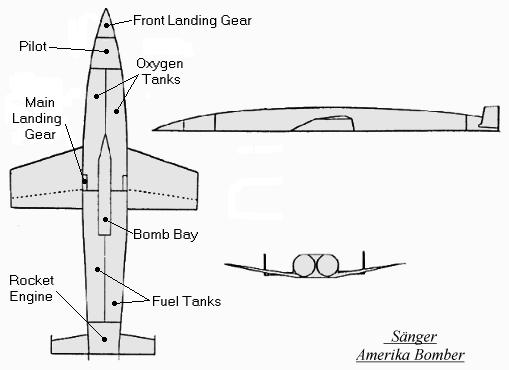 In June 1935 and February 1936, Dr. Eugen Sänger published articles
in the Austrian aviation publication Flug on rocket-powered aircraft.
This led to his being asked by the German High Command to build a secret
aerospace research institute in Trauen to research and build his "Silverbird",
a manned, winged vehicle that could reach orbit. Dr. Sänger had been
working on this concept for several years, and in fact he had began developing
liquid-fuel rocket engines. From 1930 to 1935, he had perfected (through
countless static tests) a 'regeneratively cooled' liquid-fueled rocket
engine that was cooled by its own fuel, which circulated around the combustion
chamber. This engine produced an astounding 3048 meters/second (10000 feet/second)
exhaust velocity, as compared to the later V-2 rocket's 2000 meters/second
(6560 feet/second). Dr. Sänger, along with his staff, continued work
at Trauen on the "Silverbird" under the Amerika Bomber program.
In June 1935 and February 1936, Dr. Eugen Sänger published articles
in the Austrian aviation publication Flug on rocket-powered aircraft.
This led to his being asked by the German High Command to build a secret
aerospace research institute in Trauen to research and build his "Silverbird",
a manned, winged vehicle that could reach orbit. Dr. Sänger had been
working on this concept for several years, and in fact he had began developing
liquid-fuel rocket engines. From 1930 to 1935, he had perfected (through
countless static tests) a 'regeneratively cooled' liquid-fueled rocket
engine that was cooled by its own fuel, which circulated around the combustion
chamber. This engine produced an astounding 3048 meters/second (10000 feet/second)
exhaust velocity, as compared to the later V-2 rocket's 2000 meters/second
(6560 feet/second). Dr. Sänger, along with his staff, continued work
at Trauen on the "Silverbird" under the Amerika Bomber program.
The Sänger
Amerika Bomber (or Orbital Bomber, Antipodal Bomber or Atmosphere Skipper)
was designed for supersonic, stratospheric flight (please see diagram
below). The fuselage was flattened, which helped create lift and the wings
were short and wedge shaped. There was a horizontal tail surface located
at the extreme aft end of the fuselage, which had a small fin on each end.
The fuel was carried in two large tanks, one on each side of the fuselage,
running from the wings aft. Oxygen tanks were located one on each side
of the fuselage, located forward of the wings. There was a huge rocket
engine of 100 tons thrust mounted in the fuselage rear, and was flanked
by two auxiliary rocket engines. The pilot sat in a pressurized cockpit
in the forward fuselage, and a tricycle undercarriage was fitted for a
gliding landing. A central bomb bay held one 3629 kg (8000 lb) free-falling
bomb, and no defensive armament was fitted. The empty weight was to be
approximately 9979 kg (22000 lbs).
An interesting
flight profile was envisioned for the "Silverbird". It was to be propelled
down a 3 km (1.9 mile) long monorail track by a rocket-powered sled that
developed a 600 ton thrust for 11 seconds (please see diagram
below). After taking off at a 30 degree angle and reaching an altitude
of 1.5 km (5100'), a speed of 1850 km/h (1149 mph) would be reached. At
this point, the main rocket engine would be fired for 8 minutes and burn
90 tons of fuel to propel the "Silverbird" to a maximum speed of 22100
km/h (13724 mph) and an altitude of over 145 km (90 miles), although some
sources list the maximum altitude reached as 280 km (174 miles). As the
aircraft accelerated and descended under the pull of gravity, it would
then hit the denser air at about 40 km (25 miles) and 'skip' back up as
a stone does when skipped along water (please see drawing
below). This also had the added benefit of cooling the aircraft after the
intense frictional heating encountered when the denser air was reached.
The skips would gradually be decreased until the aircraft would glide back
to a normal landing using its conventional tricycle landing gear, after
covering approximately 23500 km (14594 miles).
The final test facilities
for full-scale rocket engine tests were being built when Russia was invaded
in June 1941. All futuristic programs were canceled due to the need to
concentrate on proven designs. Dr. Sänger went on to work on ramjet
designs for the DFS (German Research Institute for Gliding), and helped
to design the Skoda-Kauba
Sk P.14. Although the Luftwaffe did its best to stop Dr. Sänger
from publishing his research results, a few copies went unaccounted for
and made their way to other countries. After the war, he was asked to work
(along with mathematician Irene Bredt) for the French Air Ministry, where
in a bizarre plot, he was almost kidnapped by Stalin, who recognized the
value of the Amerika Bomber.
 |
Model photo of the Sänger Amerika Bomber
over New York City |
 |
Model photo of the Sänger Amerika Bomber
over Chicago |
 View Josha Hildwine's Sänger "Silverbird" Orbital Bomber LuftArt images
View Josha Hildwine's Sänger "Silverbird" Orbital Bomber LuftArt images
Span: 15.0 m (49' 2")
Length: 27.98 m (91' 10")
Max. Speed: 22100 km/h (13724 mph)
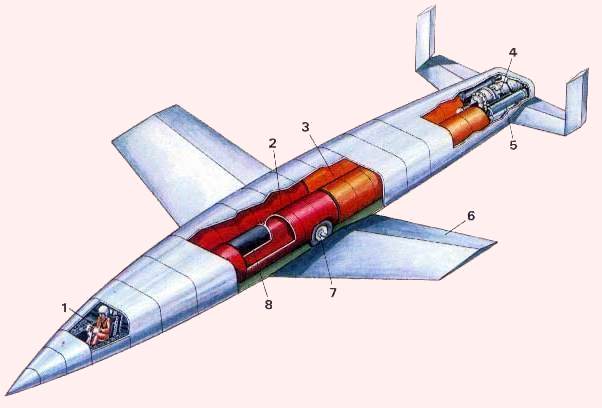
1) Pressurized Cockpit 2) Oxidant
Tanks 3) Fuel Tanks 4)
High-Pressure Combustion Chamber of 100 Tons Thrust
5) Auxiliary Rocket Chambers 6)
Wedge-Shaped Wing 7) Retracted Undercarriage
8) Free-Falling Bomb
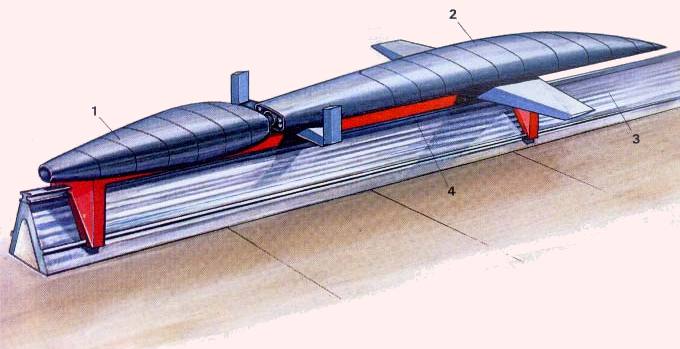
1) Captive Rocket Booster of 600 Tons Thrust
2)
Sänger Amerika Bomber of 100 Tons Thrust
3) 3 Km (1.9 miles) Long Monorail Track 4)
Sled Carriage

The diagram on the right is part of Dr. Eugen Sänger's
original proposal and shows the expected flight path that his "Silverbird"
would travel on a bomb run to New York City. Please note the skipping,
roller coaster-like path the Sänger would take before landing....
Another sketch of the Sänger
on its launching rail
1) Launch
Rail 2) Sänger Amerika Bomber
3) Launching
Sled 4) Rocket Booster |
Dr. Eugen Sänger confers with mathematician
and future wife Irene Bredt in their WWII
research lab in Trauen. |
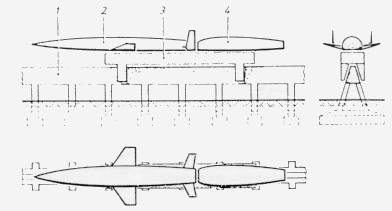 |
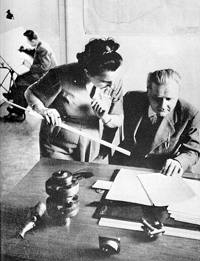 |
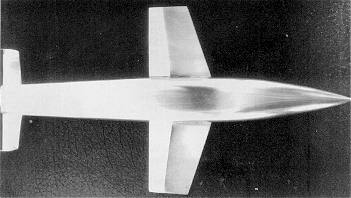
A wind tunnel model of the Sänger
Amerika Bomber, which is still in existence today....
 In June 1935 and February 1936, Dr. Eugen Sänger published articles
in the Austrian aviation publication Flug on rocket-powered aircraft.
This led to his being asked by the German High Command to build a secret
aerospace research institute in Trauen to research and build his "Silverbird",
a manned, winged vehicle that could reach orbit. Dr. Sänger had been
working on this concept for several years, and in fact he had began developing
liquid-fuel rocket engines. From 1930 to 1935, he had perfected (through
countless static tests) a 'regeneratively cooled' liquid-fueled rocket
engine that was cooled by its own fuel, which circulated around the combustion
chamber. This engine produced an astounding 3048 meters/second (10000 feet/second)
exhaust velocity, as compared to the later V-2 rocket's 2000 meters/second
(6560 feet/second). Dr. Sänger, along with his staff, continued work
at Trauen on the "Silverbird" under the Amerika Bomber program.
In June 1935 and February 1936, Dr. Eugen Sänger published articles
in the Austrian aviation publication Flug on rocket-powered aircraft.
This led to his being asked by the German High Command to build a secret
aerospace research institute in Trauen to research and build his "Silverbird",
a manned, winged vehicle that could reach orbit. Dr. Sänger had been
working on this concept for several years, and in fact he had began developing
liquid-fuel rocket engines. From 1930 to 1935, he had perfected (through
countless static tests) a 'regeneratively cooled' liquid-fueled rocket
engine that was cooled by its own fuel, which circulated around the combustion
chamber. This engine produced an astounding 3048 meters/second (10000 feet/second)
exhaust velocity, as compared to the later V-2 rocket's 2000 meters/second
(6560 feet/second). Dr. Sänger, along with his staff, continued work
at Trauen on the "Silverbird" under the Amerika Bomber program.
![]() View Josha Hildwine's Sänger "Silverbird" Orbital Bomber LuftArt images
View Josha Hildwine's Sänger "Silverbird" Orbital Bomber LuftArt images





